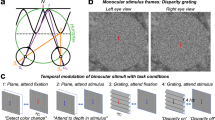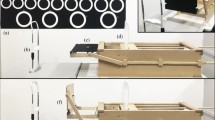Abstract
The size and depth constancies considered here operate only at near distances (< about 2 m) in a static stimulus situation with vergence as the only cue to distance. The innervation of the extraocular muscles, as evidenced by the corollary discharge, provides information about the vergence of the eyes and hence about the egocentric distance both for symmetrical and asymmetrical vergences. Size and depth constancies are regarded as the first and second stages of a linked two-stage process. In the lateral geniculate nuclei compensatory adjustments are separately applied to each retinal image as they are received from the two eyes. The modified ocular images, with their associated vertical and horizontal disparities, now provide synaptic inputs to binocularly activated cells in the visual cortex. Then, by a process akin to the induced effect, cortical cells with geniculate afferents with vertical disparities will have their outputs expressed in terms of horizontal disparities. The horizontal disparity outputs of these cortical cells are then further multiplied by the outputs from cortical cells with geniculate afferents with horizontal disparities. It is this second multiplicative process that brings about the quadratic relationship between horizontal retinal disparity and egocentric distance. The proposed mechanisms involve the known ability of the visual system to detect and respond to vertical as well as horizontal disparities and provide a definite role for the induced effect in the perceptual process. The above neural model is based on fairly simple equations that give a remarkably adequate description of the operation of the two constancies.
Similar content being viewed by others
References
Bishop PO (1989) Vertical disparity, egocentric distance and stereoscopic depth constancy: a new interpretation. Proc R Soc Lond [Biol] 237:445–469
Bishop PO (1991) Control of eye vergence and anomalous retinal correspondence. Binocular Vis Q 6:75–82
Bishop PO, Kozak W, Levick WR, Vakkur GJ (1962) The determination of the projection of the visual field on to the lateral geniculate nucleus in the cat. J Phys 163:503–539
Cumming BG, Johnston EB, Parker AJ (1991) Vertical disparities and perception of three-dimensional shape. Nature 349:411–413
Frisby JP (1984) An old illusion and a new theory of stereoscopic depth perception. Nature 307:592–593
Guthrie BL, Porter JD, Sparks DL (1983) Corollary discharge provides accurate eye position information to the oculomotor system. Science 221:1193–1195
Harting JK, Huerta MF, Hashikawa T, VanLieshout DP (1991) Projection of the mammalian superior colliculus upon the dorsal lateral geniculate nucleus: organization of tectogeniculate pathways in nineteen species. J Comp Neurol 304:275–306
Holway AH, Boring EG (1941) Determinants of apparent visual size with distance variant. Am J Psychol 54:21–37
Householder AS (1943) A theory of the size induced effect. Bull Math Biophys 5:155–160
Kisvárday ZF, Cowey A, Stoerig P, Somogyi P (1991) Direct and indirect retinal input into degenerated dorsal lateral geniculate nucleus after striate cortical removal in monkey: implications for residual vision. Exp Brain Res 86:271–292
Kries J von (1910) In: von Helmholtz H: Handbuch der physiologischen Optik, 3 German ed, 1910–1911. Hamburg, note 5, p 372. Southall JPC (translator) Treatise on physiological optics. Columbia University, 1925; reprinted Dover, New York, 1962
Lachica EA, Casagrande VA (1993) The morphology of collicular and retinal axons ending on small relay (W-like) cells in the primate lateral geniculate nucleus. Vis Neurosci 10:403–418
Leibowitz HW, Shina K, Hennessy RT (1972) Oculomotor adjustments and size constancy. Percept Psychophys 12:497–500
LeVay S, Hubel DH, Wiesel TN (1975) The pattern of ocular dominance columns in the macaque visual cortex revealed by a reduced silver stain. J Comp Neurol 159:559–576
Mayhew J (1982) The interpretation of stereo-disparity information: the computation of surface orientation and depth. Perception 11:387–403
Miles PW (1948) A comparison of aniseikonic test instruments and prolonged induction of artificial aniseikonia. Am J Ophthalmol 31:687–696
Molotchnikoff S, Casanova C, Cérat A (1988) The consequences of the superior colliculus output on lateral geniculate and pulvinar responses. In: Hicks TP, Benedek G (eds) Progress in brain research, Vol 75. Eisevier, Amsterdam, pp 67–74
Ogle KN (1938) Induced size effect. I. A new phenomenon in binocular space perception associated with the relative sizes of the images of the two eyes. Arch Ophthalmol 20:604–623
Ogle KN (1939a) Induced size effect. II. An experimental study of the phenomenon with restricted fusional stimuli Arch Ophthalmol 21:604–625
Ogle KN (1939b) Induced size effect. III. A study of the phenomenon as influenced by horizontal disparity of the fusion contours. Arch Ophthalmol 22:613–635
Ogle KN (1939c) Relative sizes of ocular images of the two eyes in asymmetric convergence. Arch Ophthalmol 22:1046–1067
Ogle KN (1940) Induced size effect with the eyes in asymmetric convergence. Arch Ophthalmol 23:1023–1038
Ogle KN (1950) Researches in binocular vision. Saunders, Philadelphia
Ono H, Comerford J (1977) Stereoscopic depth constancy. In: Epstein W (ed) Stability and constancy in visual perception. Mechanisms and processes. Wiley, New York, pp 91–128
Richards W (1968) Spatial remapping in the primate visual system. Kybernetik 4:146–156
Ritter M (1977) Effect of disparity and viewing distance on perceived depth. Percept Psychophys 22:400–407
Ritter M (1979) Perception of depth: processing of simple positional disparity as a function of viewing distance. Percept Psychophys 25:209–214
Rogers BJ, Bradshaw MF (1993) Vertical disparities, differential perspective and binocular stereopsis. Nature 361:253–255
Sobel EC, Collett TS (1991) Does vertical disparity scale the perception of stereoscopic depth. Proc R Soc Lond [Biol] 244:87–90
Stenton SP, Frisby JP, Mayhew JEW (1984) Vertical disparity pooling and the induced effect. Nature 309:622–623
Wallach H, Zuckerman C (1963) The constancy of stereoscopic depth. Am JPsychol 76:404–412
Westheimer G (1984) Sensitivity for vertical retinal image differences. Nature 307:632–634
Westheimer G, Pettet MW (1992) Detection and processing of vertical isparity by the human observer. Proc R Soc Lond [Biol] 250:243–247
Wiesel TN, Hubel DH, Lam DMK (1974) Autoradiographic demonstration of ocular-dominance columns in monkey striate cortex by means of transneuronal transport. Brain Res 79:273–279
Author information
Authors and Affiliations
Rights and permissions
About this article
Cite this article
Bishop, P.O. Size constancy, depth constancy and vertical disparities: a further quantitative interpretation. Biol. Cybern. 71, 37–47 (1994). https://doi.org/10.1007/BF00198910
Received:
Accepted:
Issue Date:
DOI: https://doi.org/10.1007/BF00198910




